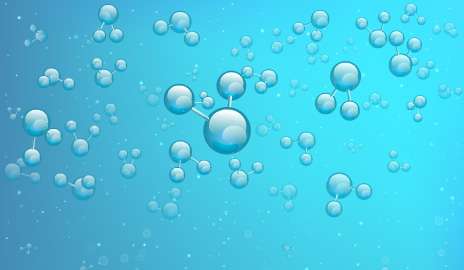Yale scientists tackle "one of the grand challenges of contemporary physical chemistry research" — where the missing proton goes.
(Phys.org) —H2O is the molecule everybody knows, and nobody can live without. But for all its familiarity and import for life, aspects of water's behavior have been hard to pin down, including how it conducts positive charge.
In the current issue of the journal Science, Yale University chemists report tracing how a cluster of water molecules adapts to the presence of an extra proton, the positively charged subatomic particle.
Water constantly encounters stray protons—in biological contexts, as when light impinges on the eye's retina, for example, or in purely chemical contexts, as when water is split by electrolysis, or in technological contexts, as in the operation of fuel cells.
The new research results provide long-sought experimental data that advance understanding of water's ability to conduct charge, and researchers expect the data to help theoretical chemists simulate how positive charge propagates through a more extended three-dimensional water network. This in turn will shed light on the way positive charge moves in biological systems.
"Getting this right is one of the grand challenges of contemporary physical chemistry research, and we believe we've taken a big step," said Yale chemist Mark Johnson, the lead investigator. "We now have a clear picture of how an extra proton effectively 'hides' in a three-dimensional water network, solving a decade-long mystery raised by earlier work that revealed everything except the lair of that critical proton."
Scientists have long known and understood how water conducts negative charge (electrons). But showing how positive charge moves through water has been difficult because water molecules are not spectators in the process, Johnson said, but rather "are in fact intrinsic to the effect."
The researchers used advanced laser spectroscopy and mass spectrometry techniques to identify the presence and movement of a proton in the three-dimensional structure of the H+(H2O)21 cluster, an extremely stable group of water molecules first observed by the late Nobel laureate and Yale professor John Fenn.
Slow cooling of the water cluster close to absolute zero was key, allowing the nano-crystals (all of the individual H+(H2O)21 clusters) to freeze into the same shape, removing clutter that obscured previous spectroscopic pictures.
The results showed that the cluster has unique infrared signatures for each type of water molecule in the network, from the ones closest to the proton to the ones farthest away. These signatures were specific enough to provide detailed insight into how the proton affects each water molecule, and can be used to test and improve the most advanced theoretical calculations.
"It will be important to follow how these signatures evolve with cluster size and increasing temperature," said lead author Joseph Fournier, a graduate student in Johnson's lab.
The paper, published May 30, is titled "Vibrational spectral signature of the proton defect in the three-dimensional H+(H2O)21 cluster."
More information: "Vibrational spectral signature of the proton defect in the three-dimensional H+(H2O)21 cluster." Joseph A. Fournier, Christopher J. Johnson, Conrad T. Wolke, Gary H. Weddle, Arron B. Wolk, Mark A. Johnson. Science 30 May 2014: Vol. 344 no. 6187 pp. 1009-1012 DOI: 10.1126/science.1253788
Journal information: Science
Provided by Yale University























